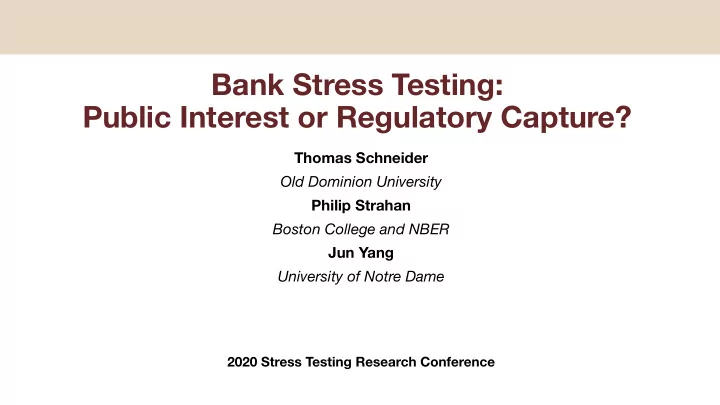

Bank Stress Testing: Public Interest or Regulatory Capture? Thomas Schneider Old Dominion University Philip Strahan Boston College and NBER Jun Yang University of Notre Dame 2020 Stress Testing Research Conference
Research Questions • Does banks’ influence on regulators affect stress test outcomes? • Regulatory capture vs Public Interest “... as a rule, regulation is acquired by the industry and is designed and operated primarily for its benefit” – Stigler (1971) • Setting U.S. Stress Tests (2013-2019)
Measuring influence • Does banks’ influence on regulators affect stress test outcomes? • Large Trading Banks (TBTF) BoA, Citigroup, Goldman Sachs, JPMorgan, Morgan Stanley, Wells Fargo
Measuring influence • Does banks’ influence on regulators affect stress test outcomes? • Large Trading Banks (TBTF) BoA, Citigroup, Goldman Sachs, JPMorgan, Morgan Stanley, Wells Fargo • Regulatory Connections Banks with executive officers who have held senior positions at bank regulators • Political Connections Political contributions + lobbying expenses over the past two congressional election cycles, scaled by assets
Stress Tests • Does banks’ influence on regulators affect stress test outcomes ? • Comprehensive Capital Analysis and Review (CCAR) • Dodd-Frank Act Stress Tests, run by the Fed (DFAST-Fed) • Dodd-Frank Act Stress Tests, run by banks (DFAST-Bank)
Stress Tests • Does banks’ influence on regulators affect stress test outcomes ? CCAR vs DFAST-Fed DFAST-Fed vs DFAST-Bank Similarities Similarities Fed’s model and scenarios Fed’s scenarios Banks’ (start) positions Flat capital distribution Banks’ (start) positions Differences Differences Banks’ proposed capital distribution Fed’s model vs Banks’ model plan vs flat capital distribution Qualitative test
1. Who are more stressed? • Exposure to stress test: • Exposure = Starting Capital Ratio – Stressed Minimum
1. Who are more stressed? • Takeaways: • Large trading banks’ portfolios are much more stressed than that of other banks. • Effect goes beyond the Global Market Shock • Additional tests rule out riskiness • No evidence of favoritism to banks with regulatory or political influence
2. Who fails CCAR? Any Failure • Takeaways: Trading Bank 0.22** 0.17** (0.09) (0.08) Regulatory Connection -0.04 -0.04 • Large trading banks are more (0.07) (0.07) likely to fail. Political Connection 0.02 0.01 (0.04) (0.04) Not Below Any Barrier, DFAST-Bank Identified 0 Min Distance, DFAST-Bank (0.03) 0.58*** Below Any Barrier, DFAST-Fed (0.16) -0.05* Min Distance, DFAST-Fed (0.02) Yes Yes Year FEs 154 154 Observations 0.06 0.13 Adjusted R-squared
2. Who fails CCAR? Any Failure • Takeaways: Trading Bank 0.22** 0.17** (0.09) (0.08) Regulatory Connection -0.04 -0.04 • Large trading banks are more (0.07) (0.07) likely to fail. Political Connection 0.02 0.01 • Face greater scrutiny on the qualitative dimensions (0.04) (0.04) Not Below Any Barrier, DFAST-Bank • More aggressive capital plans Identified 0 Min Distance, DFAST-Bank (0.03) 0.58*** Below Any Barrier, DFAST-Fed (0.16) -0.05* Min Distance, DFAST-Fed (0.02) Yes Yes Year FEs 154 154 Observations 0.06 0.13 Adjusted R-squared
2. Who fails CCAR? Any Failure • Takeaways: Trading Bank 0.22** 0.17** (0.09) (0.08) Regulatory Connection -0.04 -0.04 • Large trading banks are more (0.07) (0.07) likely to fail. Political Connection 0.02 0.01 • Face greater scrutiny on the qualitative dimensions (0.04) (0.04) Not Below Any Barrier, DFAST-Bank • More aggressive capital plans Identified 0 Min Distance, DFAST-Bank • Political or Regulatory connections (0.03) 0.58*** do not matter Below Any Barrier, DFAST-Fed (0.16) -0.05* Min Distance, DFAST-Fed (0.02) Yes Yes Year FEs 154 154 Observations 0.06 0.13 Adjusted R-squared
3. Who ‘knows’ the Fed’s model? • Takeaway: no evidence of influential banks have a better understanding of the Fed’s model
Evolution of Capital • Within tested banks, trading banks are better capitalized.
Conclusions • Public Interest View • Large trading banks (TBTF) • Face tougher stress tests • Are more likely to fail • Make more conservative capital plans
Conclusions • Public Interest View • Large trading banks (TBTF) • Face tougher stress tests • Are more likely to fail • Make more conservative capital plans • But things are changing… • Less disclosure of results • More disclosure of Fed’s model • Looser connection between test results and capital plans
Recommend
More recommend